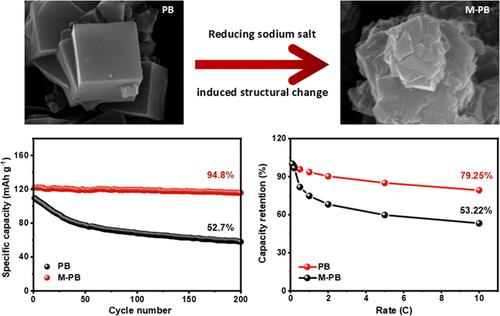Sodium-Rich Prussian Blue Analogs Synthesized with Reducing Sodium Salt for Enhanced Rate and Cycling Stability Sodium-Ion Storage
IF 8.2
2区 材料科学
Q1 MATERIALS SCIENCE, MULTIDISCIPLINARY
引用次数: 0
Abstract
Prussian blue analogs (PBAs) as cathode material for sodium-ion batteries have attracted widespread attention due to their affordability, simple synthesis, and high theoretical capacity. Nevertheless, the oxidation of Fe2+ and sodium loss lead to poor electrochemical properties which restrict the practical use of PBAs. Herein, a simple coprecipitation approach based on sodium salt-reduction-assisted synthesis was proposed to construct high-sodium PBAs. The sodium bisulfite (NaHSO3) not only effectively inhibits the oxidation of Fe2+ but also increases the mole ratio of Na+ in the resulting products. The optimized sample exhibits excellent specific capacity (131.1 mAh g–1 at 0.1C), high rate performance (103.9 mAh g–1 at 10C), and good cyclic performance (94.8% capacity retention after 200 cycles). Experimental results reveal that the sample synthesized with sodium bisulfite possesses improved sodium-ion diffusion kinetics and stable crystal structure. In this study, a scalable method is introduced for the synthesis of PBAs with excellent electrochemical properties and further applications.

还原钠盐合成富钠普鲁士蓝类似物以提高钠离子储存速率和循环稳定性
普鲁士蓝类似物(PBAs)作为钠离子电池正极材料,因其价格低廉、合成简单、理论容量高等优点而受到广泛关注。然而,Fe2+的氧化和钠的损失导致PBAs的电化学性能差,这限制了它的实际应用。本文提出了一种基于钠盐还原辅助合成的简单共沉淀法来构建高钠PBAs。亚硫酸氢钠(NaHSO3)不仅能有效抑制Fe2+的氧化,还能提高产物中Na+的摩尔比。优化后的样品具有优异的比容量(0.1C时为131.1 mAh g-1)、高倍率性能(103.9 mAh g-1)和良好的循环性能(200次循环后容量保持率为94.8%)。实验结果表明,用亚硫酸氢钠合成的样品具有更好的钠离子扩散动力学和稳定的晶体结构。在本研究中,介绍了一种可扩展的方法来合成具有优异电化学性能和进一步应用的PBAs。
本文章由计算机程序翻译,如有差异,请以英文原文为准。
求助全文
约1分钟内获得全文
求助全文
来源期刊

ACS Applied Materials & Interfaces
工程技术-材料科学:综合
CiteScore
16.00
自引率
6.30%
发文量
4978
审稿时长
1.8 months
期刊介绍:
ACS Applied Materials & Interfaces is a leading interdisciplinary journal that brings together chemists, engineers, physicists, and biologists to explore the development and utilization of newly-discovered materials and interfacial processes for specific applications. Our journal has experienced remarkable growth since its establishment in 2009, both in terms of the number of articles published and the impact of the research showcased. We are proud to foster a truly global community, with the majority of published articles originating from outside the United States, reflecting the rapid growth of applied research worldwide.
 求助内容:
求助内容: 应助结果提醒方式:
应助结果提醒方式:


